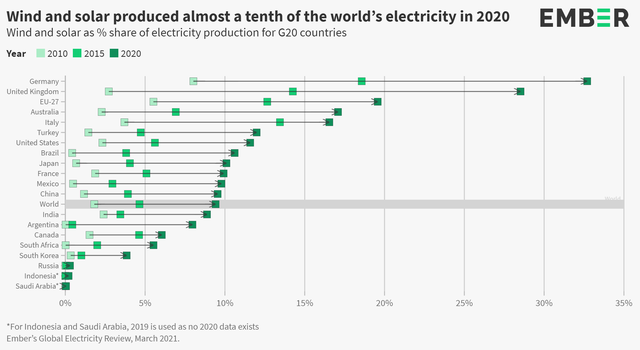
Wind and solar generated 10% of global electricity for the first time in 2021, a new analysis shows.
Fifty countries get more than a tenth of their power from wind and solar sources, according to research from Ember, a climate and energy think tank.
As the world’s economies rebounded from the Covid-19 pandemic in 2021, demand for energy soared.
Demand for electricity grew at a record pace. This saw a surge in coal power, rising at the fastest rate since 1985.
The research shows the growth in the need for electricity last year was the equivalent of adding a new India to the world’s grid.

Solar and wind and other clean sources generated 38% of the world’s electricity in 2021. For the first time wind turbines and solar panels generated 10% of the total.
The share coming from wind and sun has doubled since 2015, when the Paris climate agreement was signed.
The fastest switching to wind and solar took place in the Netherlands, Australia, and Vietnam. All three have moved a tenth of their electricity demand from fossil fuels to green sources in the last two years.
“The Netherlands is a great example of a more northern latitude country proving that it’s not just where the Sun shines, it’s also about having the right policy environment that makes the big difference in whether solar takes off,” said Hannah Broadbent from Ember.
Vietnam also saw spectacular growth, particularly in solar which rose by over 300% in just one year.
“In the case of Vietnam, there was a massive step up in solar generation and it was driven by feed-in tariffs – money the government pays you for generating electricity – which made it very attractive for households and for utilities to be deploying large amounts of solar,” said Dave Jones, Ember’s global lead.
“What we saw with that was a massive step up in solar generation last year, which didn’t just meet increased electricity demand, but it also led to a fall in both coal and gas generation.”
Despite the growth and the fact that some countries like Denmark now get more than 50% of their electricity from wind and solar, coal power also saw a remarkable rise in 2021.

A large majority of the increased demand for electricity in 2021 was met by fossil fuels with coal fired electricity rising by 9%, the fastest rate since 1985.
Much of the rise in coal use was in Asian countries including China and India – but the increase in coal was not matched by gas use which increased globally by only 1%, indicating that rising prices for gas have made coal a more viable source of electricity.
“The last year has seen some really super high gas prices, where coal became cheaper than gas,” said Dave Jones.
“What we’re seeing right now is gas prices across Europe and across much of Asia being 10 times more expensive than they were this time last year, where coal is three times more expensive.
He called the price rises for both gas and coal: “a double reason for electricity systems to demand more clean electricity, because the economics have shifted so fundamentally.”
The researchers say that despite the coal resurgence in 2021, major economies including the US, UK, Germany, and Canada are aiming to shift their grids to 100% carbon free electricity within the next 15 years.
This switch is being driven by concerns over keeping the rise in the world’s temperature under 1.5C this century.
To do that, scientists say that wind and solar need to grow at around 20% every year up to 2030.
The authors of this latest analysis say this is now “eminently possible”.
The war in Ukraine could also give a push to electricity sources that don’t depend on Russian imports of oil and gas.
“Wind and solar have arrived, and they offer a solution out of the multiple crises that the world is facing, whether it’s a climate crisis, or the dependence on fossil fuels, this could be a real turning point,” said Hannah Broadbent.
Ember’s Global Electricity Review can be found here.
Source BBC


